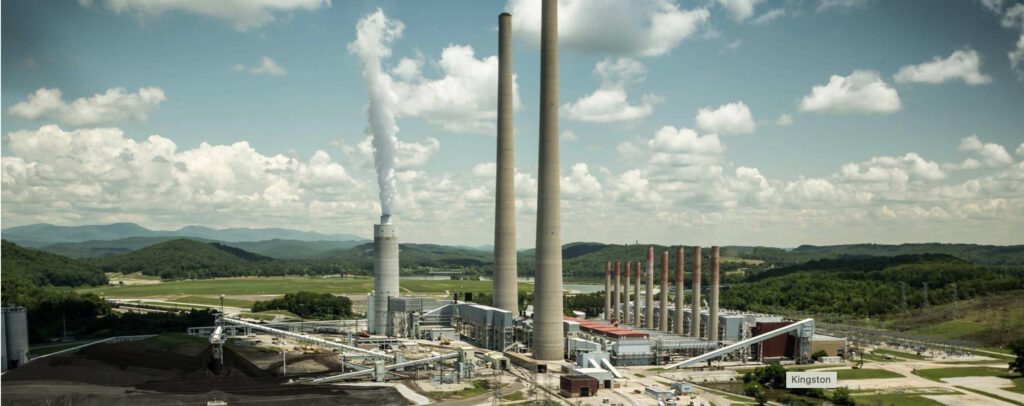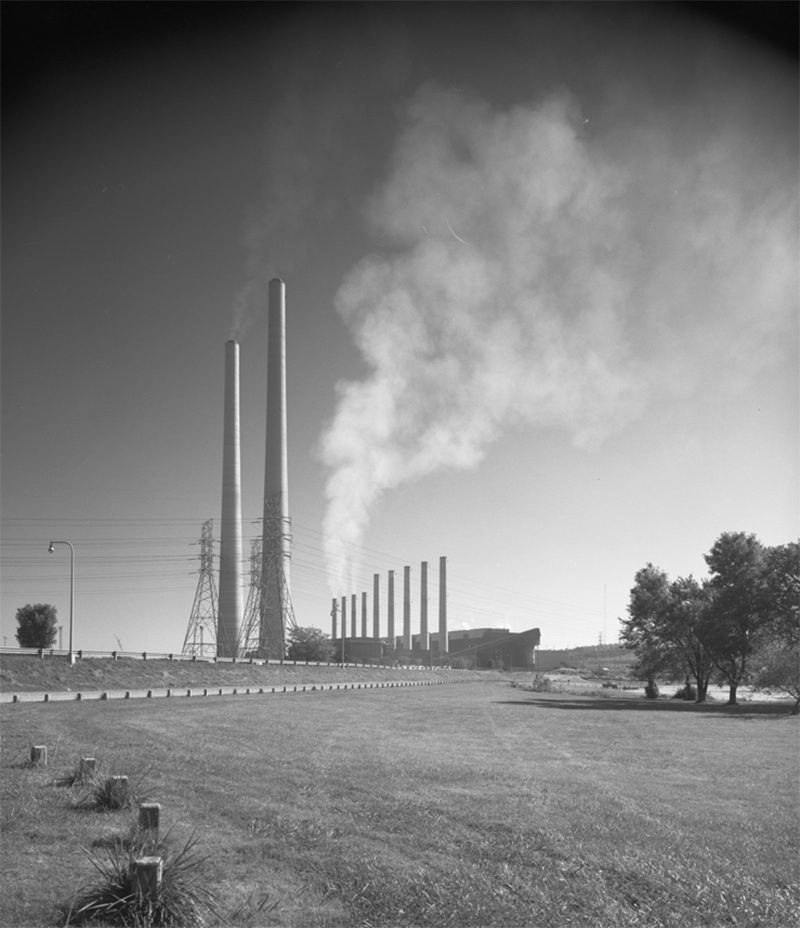TVA to Replace Iconic Kingston Coal Plant With 1.5-GW Modern Complex
The Tennessee Valley Authority (TVA) has moved to retire its iconic 1.3-GW Kingston Fossil Plant in Tennessee in 2027 and replace it—with notable urgency—with a 1.5-GW modern complex featuring a combined cycle gas turbine (CCGT) plant, aero-derivative turbines, 100 MW of battery storage, and up to 4 MW of solar generation.
The nation’s largest public power company said its “difficult” decision unveiled on April 2 to retire the nine-unit coal facility in Roane County follows a multi-year public process. In a record of decision (ROD), TVA said the “need for [Kingston] to operate at full capacity has decreased” given the evolution of its generating fleet over the past 10 to 15 years—primarily driven by additions of nuclear, gas, and renewable resources.
TVA said it had resorted to more frequent cycling of Kingston’s units to meet fluctuating loads. “However, [Kingston] was not designed for these types of operations, which presents reliability challenges that are difficult to anticipate and expensive to mitigate,” it said. The coal plant’s design capacity of 1.7 GW had fallen to a summer net generating capacity of 1.3 GW, given the “effects of aging equipment and long-term fuel blend changes,” TVA noted. “As TVA continues to transition the rest of its fleet to cleaner and more flexible technologies, [Kingston] will continually be challenged to operate reliably,” it said.
The utility also highlighted the “significant monetary investment” required to comply with federal environmental rules, including the Environmental Protection Agency’s 2020 Effluent Limitation Guidelines. “Continued operation of [Kingston] beyond 2027 would create operational, and therefore reliability risks in TVA’s system due to the deteriorating condition of the coal units,” the ROD notes.
In addition, if Kingston’s operation continued beyond 2027, it would “likely result in cascading delays for the later planned retirements in TVA’s phased 2035 coal fleet retirement plan and cause delay in TVA’s plans to integrate more solar and storage assets onto the system,” it said. “Thus, [Kingston] was recommended for retirement by the end of 2027.”

An Urgency to Replace Kingston’s Generation with 1.5 GW by 2027
Kingston’s generation will be replaced with the operation of a natural gas-fired CCGT combined with 16 dual-fueled aero-derivative combustion turbines, a 3 MW to 4 MW solar site, a 100-MW battery storage site, along with a new 161-kV switchyard on the Kingston Reservation. “This will be a first-of-its-kind facility at TVA,” the utility noted.
A TVA spokesperson told POWER the ROD kicks off the technology selection and procurement process. “Until now no decisions have been made,” he said. However, he noted TVA is targeting starting operations at the gas-fired power plant before Kingston is retired at the end of 2027. The ROD underscores that urgency, noting that the replacement generation “must continue to maintain the planning reserve margins and to provide transmission system voltage support to the local area that is needed to maintain overall system stability and reliability.”
For now, TVA plans to supply the new gas-fired units with fuel procured via a new 122-mile natural gas pipeline, dubbed the “Ridgeline Expansion Project.” East Tennessee Natural Gas (ETNG) will build the pipeline and associated compressor station, and metering and regulation facilities. The pipeline project will require approval from the Federal Energy Regulatory Commission (FERC).
The replacement plan is a preferred alternative outlined in TVA’s 2019 Integrated Resource Plan (IRP), which led the utility to begin conducting end-of-life evaluations of its operating coal-fired fleet. Those evaluations ultimately led the utility to conclude that retiring its entire coal fleet by 2035 would “align with least-cost planning and reduce economic, reliability, and environmental risks.”
Specifically, for Kingston, the evaluation indicated “that these units need to be replaced by the end of 2027 due to the deteriorating condition of those units,” a spokesman said. “The preferred alternative for replacement generation—the energy complex which includes natural gas, solar and battery storage—will give us the flexible, dispatchable generation we need in the next five years.”
The urgency to build replacement generation is also bolstered by Kingston’s unique location in East Tennessee, the ROD suggests. While the utility has an active interconnection queue of close to 30 GW, more than half is for solar and storage, and TVA recognizes a “significant portion” may be non-viable. Meanwhile, “Renewable projects in queue tend to be located in areas that are more suitable for solar, such as West Tennessee, North Alabama, and North Mississippi, not in the East Tennessee region where [Kingston] is located,” it notes. “The queued projects are not capable of meeting the purpose and need to support generation in the East Tennessee region and to provide replacement capacity by the end of 2027.”
However, according to TVA President and CEO Jeff Lyash, the opportunity to build replacement generation may offer solid new prospects as decarbonization builds momentum. Modern gas-fired technology provides options, he noted. It is “technology that, in the long run, may be hydrogen fuel, it can be backed with carbon capture when that technology is available,” he said on Tuesday. “This benefits energy security and sustainability here in eastern Tennessee and across our whole seven-state footprint.”
Kingston Fossil Plant: An Iconic Coal Plant
Still, TVA’s decision to replace Kingston’s coal-fired units is monumental. While TVA began its coal-fired construction program in the 1940s to carry out its original mission to spur economic development in the Tennessee Valley and Appalachia, the majority of its coal units were placed in service between 1951 and 1973.
But today, TVA operates only four coal-fired power plants, a dramatic reduction from just 10 years ago, when TVA produced 74,583 GWh—or about 52% of its total generation—from 53 active units at 11 coal plants. Along with Kingston, TVA’s coal-fired operating fleet includes the 2.5-GW, two-unit Cumberland station in Tennessee, four units at the 976-MW Gallatin plant in Tennessee, and the 1.2-GW, nine-unit Shawnee plant in Kentucky.
A map showing TVA’s assets across its seven-state footprint. Source: TVA
In 2023, TVA approved the retirement of Cumberland, which has operated since 1968, by 2028, moving to replace it with a 1,450-MW natural gas-fired CCGT. Cumberland’s gas units are slated to be online by the end of 2026, when the first coal unit retires, a spokesperson told POWER. “No decisions have been made on the retirement of Gallatin and Shawnee,” he added. At Shawnee, notably, TVA is slated to pioneer a 100-MW utility-scale solar generation site built on the plant’s closed 309-acre coal ash site using a patented closure cap system called ClosureTurf. The project, dubbed “Project Phoenix,”could be online by the summer of 2028, TVA said.
Over the past year, meanwhile, TVA has added about 1.5 GW of new gas-fired generation. These include three combustion turbine units, a combined 750 MW, at the Colbert Combustion Turbine site in North Alabama. In December 2023, it added another 750 MW with three new units at the Paradise Combined Cycle plant near Drakesboro, Kentucky. More gas units are slated to come online over the next few years. Along with the Cumberland CCGT, TVA plans to add 500 MW of peaking aero-derivative combustion turbines at Johnsonville in late 2024 and 300 MW of solar at Lawrence County and Shawnee by late 2028.

Kingston’s nine units were built between 1951 and 1955 on the 2,254-acre Kingston Reservation on the Clinch and Emory rivers in Harriman, Roane County, as a solution to meet the growing demand for energy from the nearby Oak Ridge National Laboratory. The national lab, at the time, “was ramping up production of atomic defense material due to the Korean conflict,” TVA notes. When it was finished in 1955, Kingston “stood as the largest coal-burning power plant in the world—a distinction it held for more than a decade,” it says. While the plant burned about 14,000 tons of coal a day, it furnished the region with reliable power—of about 10 TWh a year.
The plant’s historic legacy, however, also includes a devastating coal ash disaster in December 2008, which released 1.1 billion gallons of coal fly ash slurry. The disaster stemming from a broken dike was said to have left 4 or 5 feet of water and mud over 250 to 400 acres of rural land. The incident prompted the Obama administration to develop new rules regulating coal combustion ash. TVA has since implemented several measures to monitor and contain its coal ash from operating and shuttered coal plants. In 2022, TVA recycled 82% of the coal ash produced for the manufacture of wallboard and cement, as well as a replacement for Portland cement in concrete.
A ‘Very Difficult’ Decision
TVA’s executives on Tuesday hailed Kingston’s 70-year legacy and its regional significance. “Kingston has been a workhorse for TVA for over 70 years. It’s part of the success of this region,” said Lyash. “And so it’s with great pride that we move on from these units and retire, but they need to be replaced. The area is growing,” he added. “Retiring these units and replacing them with technology that is more reliable, more resilient, and cleaner is not an easy decision, but it’s the right thing to do for our energy security going forward.”
Kris Edmondson, TVA vice president of Power Operations, also noted the decision to retire the iconic plant was “very difficult,” given its place in TVA culture. “One of the most challenging things when you retire a coal plant is the impact on the people. And at Kingston, we’ve got almost 200 employees there,” he said.
“They’re very committed, talented craftsmen, operations, maintenance [who] have done an exceptional job meeting the mission. And so for each of them, when we say we’re closing a plant, it’s impactful. It’s an element of uncertainty—[they ask] what’s next for me?” he said. “And so one of the things that’s really important for us as we make this transition is making sure we support all of our employees with next steps.”
Edmonton said TVA already has a detailed workforce plan in place to “maintain coal plant expertise and provide opportunities for employees to evaluate options and prepare for next career steps.” The plan includes opportunities to transfer to other TVA locations “where employee skillsets are needed, positions in other technologies offering training to support the transition to a new job in TVA, and supporting employees interested in retiring,” he said.
—Sonal Patel is a POWER senior editor (@sonalcpatel, @POWERmagazine).